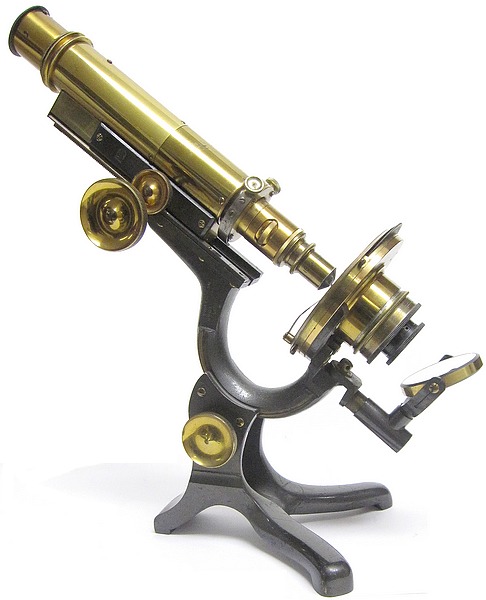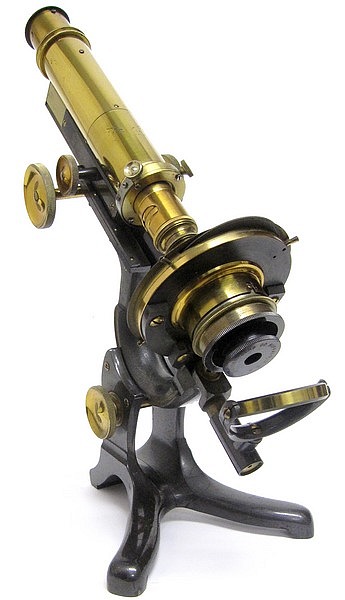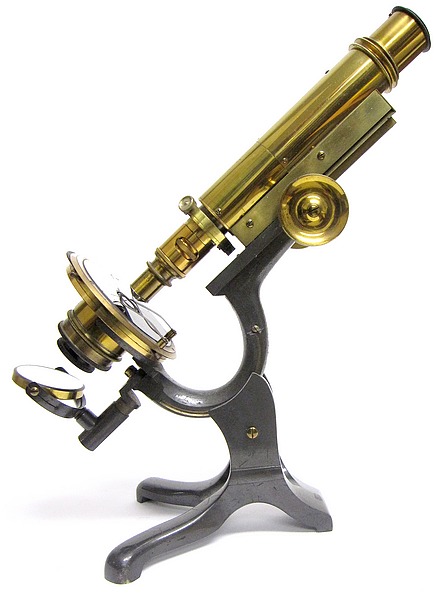
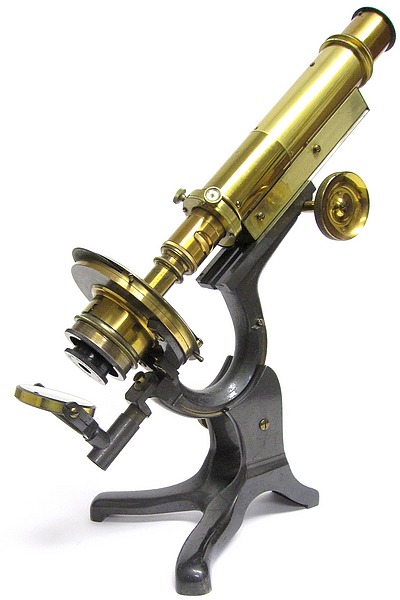
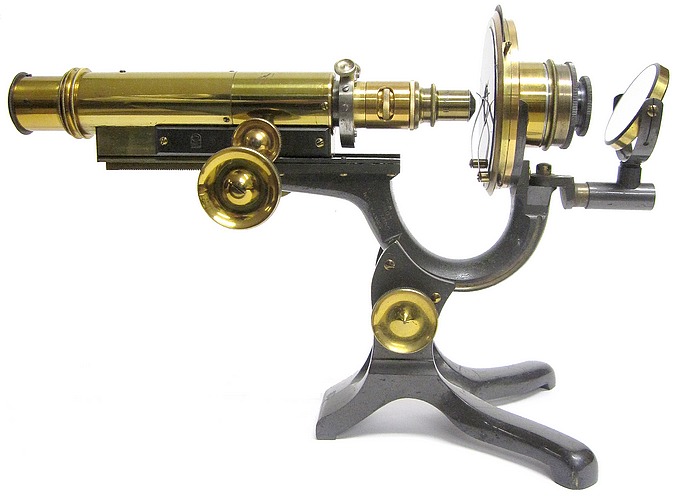
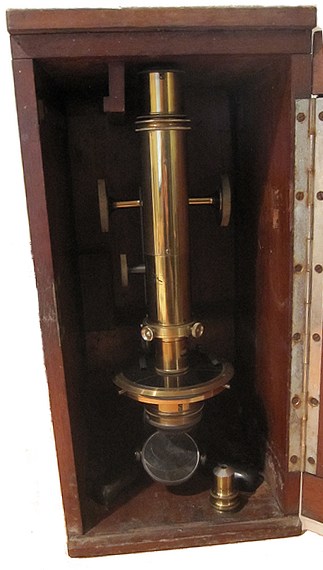
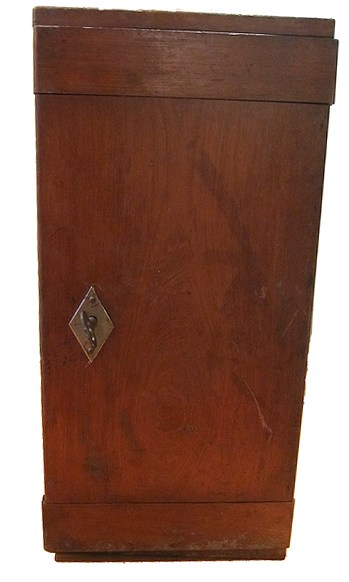
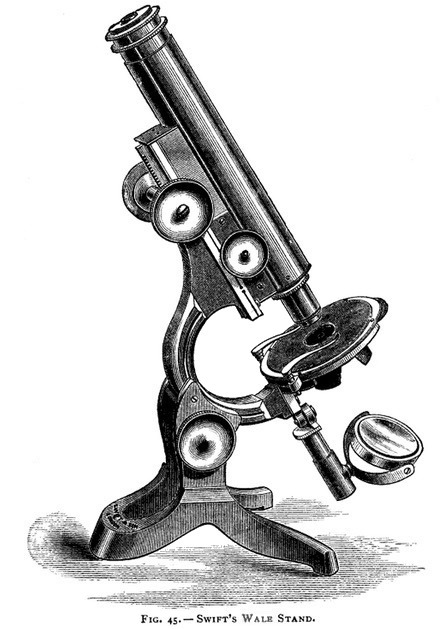
The microscope is signed on the limb Swift & Son, University St, London W.C. with the Swift bird trade mark. The firm had this name and address during the years 1877-1881. This microscope is based on a design first introduced by George Wale in 1879 with his "New Working Microscope", which featured a limb allowing a novel way to incline the microscope. Evidently, Swift thought this was a useful feature. He first used this with a microscope called the Improved Wale's American Microscope and later he applied this feature to some more advanced models. The microscope shown here is constructed in brass with bright lacquered and black oxidized surface finishes. As opposed to the standard version of this model, it has additional features that arrange it into a polarizing (mineral/petrological) microscope. The storage case now with the microscope is a replacement.
The standard version of this model is illustrated and described in The American Monthly Microscopical Journal, Volume 4, 1883 as follows:
"Another ingenious contrivance applied to some of Mr. Swift's stands is precisely what we have endeavored to induce our own manufacturers to adopt, but without success. It is a revolving plate of diaphragms fitted in the stage-plate. This is shown in the illustration (fig. 45), of the modification of the stand first introduced by Mr. George Wale, made by Messrs. Swift & Son, under the name of the Improved Wale's American Microscope. The milled edge of the diaphragm-plate is seen projecting from the front of the stage-plate. The device is not new, being in fact, as we are told, a very old one; but it is none the less good, and Messrs. Swift & Son apply it to several of their microscopes.
The design of the Wale stand, as applied by Mr. Swift, seems to have been suggested by the radial microscope devised by Mr. Wenham, while the plan of construction is copied from the simple and inexpensive stand of Mr. Wale, which has been so highly commended by Dr. W. B. Carpenter, and others. At first glance it appears to be almost identical with the last mentioned instrument, but it possesses this peculiarity that the centre of curvature of the rocker is at the focal point for an object on the stage. The small milled head beneath the coarse adjustment is for the fine adjustment, the plan of which will be described in a future article.
Unlike the standard version of this model, the microscope shown on this page has some additional features that convert it into a polarizing (mineral/petrological) microscope. Among these features is a sub-stage that is fitted with a polarizing condenser that can be rotated, a stage with centering adustments that is capable of full rotation through the optical axis, and a centering nosepiece onto which attaches the analyzing prism and objective.
The microscope has Swift's novel fine adjustment mechanism, which is described in the Journal of the Royal Microscopical Society, 1881 as follows:
"The principal novelty is the fine adjustment (Fig. 43, nearly full size). A is a brass plate having short angle-bearings at either end sliding in the grooves B B and carrying at the lower end a ring into which the objectives are screwed. A spiral spring C presses down the plate A. The focussing is by means of the fine screw worked by the milled head F, the point of which acts upon the trigger-shaped lever D (attached to the side), which pushes against the small metal disk E (mounted on A and rotating on a pinion to diminish friction) and this lifts up the slide A against the pressure of the spiral spring above. The ring carrying the objective is quite independent of the microscope-body, and should the slide A be found to work too easily or the reverse, the bearings can be readily adjusted by the capstan screw-heads shown at the side.
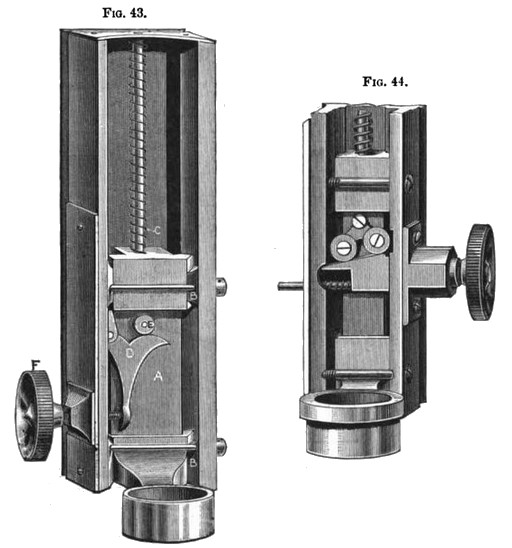
An improved application of this fine adjustment has since been devised, as shown in Fig. 44; the modification consisting of a wedge-shaped lever worked by the fine-focussing screw (against a short spiral spring) and acting on the slide A by means of the two small revolving disks attached loosely by a triangular fitting to the pinion at E. By making the slope of the wedge very acute, and the thread of the screw very fine, the focussing movement is rendered unusually delicate. This latter form of fine adjustment is designed to be applied to more expensive Microscopes".
The microscope shown here utilizes the earlier form of the fine adjustment shown in fig. 43.
The James Swift & Son business timeline.
